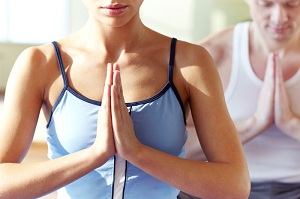
Breathing
Yoga utilizes deep, slow breathing techniques. Research has shown that when you slow your normal breathing patterns, you also trigger certain nerves within the sympathetic nervous system. It is here that your brain registers how much pain you are feeling and the rate at which the pain is released. Many of the techniques are the same as those used in Lamaze breathing which women in labor practice to curb contraction pain.
The fibers found in the central nervous system also regulate skin temperature and the rate of blood flow. Studies and research have shown that by adjusting your breathing, you are simultaneously reducing the amount of pain felt within the sympathetic nervous system; therefore, ensuring that the pain felt will be less acute.
You engage in approximately 15 to 18 breaths per minute and sometimes more when you are having a high rate of pain. As your stress levels increase (which often happens when we feel pain) your breathing becomes quicker and shallower, thereby, increasing your blood flow and triggering your nerve endings. At this point, the pain you are experiencing will also increase.
When engaging in Yoga it is recommended that you slow your breathing down to 6 to 10 breaths per minute. This will calm the sympathetic nervous system, decrease stress levels and ultimately reduce the amount of pain felt.
Yoga breathing is often referred to as pranayama. When practicing this as a method to reduce pain, first find a comfortable and quiet place to sit or lay. Then focus on your breathing and slowing it down. Begin at the top of your head and concentrate on relaxing each part of your body until you have reached the tips of your toes.
Count your breaths quietly. Practice inhaling deeply to the count of 5 and hold your breath for a moment or two. Then slowly exhale the breath in a slow, rhythmic pace to the count of 10. It may take several sessions but this will help you practice slower breathing.
Poses
One of the most popular yoga poses for reducing pain is called the ‘snake pose’ or ‘cobra.’ If you suffer back pain, this is a great pose. To do this pose, find a comfortable place on the floor and lie down on your stomach while extending your legs fully. The tops of your feet, stomach, thighs and groin should also be touching the floor. Extend your arms reaching forward.
As you inhale deeply, keep your arms straight and then gently begin to lift your chest off the floor and hold the position for a few moments. Lift your chest only as high as is comfortable for you. Release the position and return to the starting position. Repeat this stretch a few times while maintaining your deep breathing the entire time.
The ‘dolphin’ pose is also helpful in alleviating pain especially if you suffer from fibromyalgia. This pose will help you strengthen your core muscles. To do this pose, get into a cat-like position with your hands and knees firmly pressed to the floor. Your knees should be aligned with your hips and your hands aligned with your shoulders.
Begin your deep breathing and at the same time, gently and gradually lift your knees up off of the floor while keeping your back straight. Be sure to keep your hands flat to the floor for support. Straighten your knees as much as is comfortable. When you have reached the point to where you can’t straighten them anymore without discomfort, hold the position for a few moments. Continue to breathe deeply and upon your last exhale, release your knees and return to your starting position.
This movement should be slow and steady and may take some practice, as it requires some balance and utilizing your core muscles. Repeat the exercise a few times or for as many as you can comfortably do. This is a great exercise for reducing tension in the neck and shoulder area known to cause headaches as well as assisting in reducing the inflammation around the disks in the back.
Here are three yoga studios located in the South Bay you may want to visit to experience yoga for yourself:
In addition to yoga, the simple act of stretching can help improve flexibility. Try self myofascial release with a foam roller to ease aches and pains.
For more articles go to http://lifesportfitness.lifestyleezine.com
